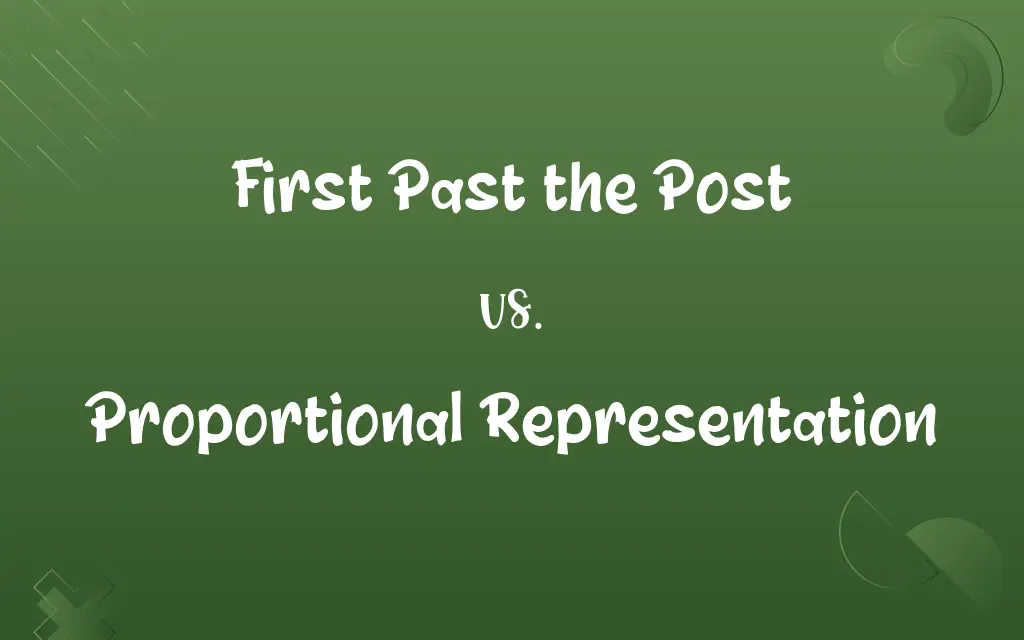First Past the Post vs. Proportional Representation: Know the Difference

By Shumaila Saeed || Published on February 15, 2024
First Past the Post is a voting system where the candidate with the most votes wins, while Proportional Representation allocates seats based on the percentage of votes each party receives.

Key Differences
First Past the Post (FPTP) is a simple majority system, where the candidate with the most votes in a constituency wins, often leading to a two-party system. In contrast, Proportional Representation (PR) aims to mirror the electorate's preferences in the legislature, often resulting in multi-party systems.
Shumaila Saeed
Feb 15, 2024
FPTP can lead to 'wasted votes' as only the winning vote in each constituency counts, whereas PR values every vote, translating them into seats and reducing wasted votes.
Shumaila Saeed
Feb 15, 2024
In FPTP, smaller parties often struggle to gain representation, as they must win outright in constituencies. However, PR allows smaller parties to gain seats even with a small percentage of the overall vote, encouraging diversity.
Shumaila Saeed
Feb 15, 2024
FPTP often leads to majority governments and stable administrations, but may not reflect the true diversity of public opinion. PR, while offering a more accurate reflection of voters' preferences, can lead to coalition governments and potential instability.
Shumaila Saeed
Feb 15, 2024
FPTP is simpler and more straightforward, with voters choosing a single candidate, while PR systems can be more complex, with voters either choosing parties or ranking candidates based on preference.
Shumaila Saeed
Feb 15, 2024
ADVERTISEMENT
Comparison Chart
Winner Determination
Candidate with most votes in a constituency wins
Seats allocated based on percentage of overall votes
Shumaila Saeed
Feb 15, 2024
Impact on Party System
Favors a two-party system
Encourages a multi-party system
Shumaila Saeed
Feb 15, 2024
Vote Utilization
Can lead to wasted votes
Reduces wasted votes, every vote contributes to outcome
Shumaila Saeed
Feb 15, 2024
Representation of Minor Parties
Difficult for minor parties to win seats
Easier for minor parties to gain representation
Shumaila Saeed
Feb 15, 2024
Government Stability
Often leads to majority governments
Can result in coalition governments
Shumaila Saeed
Feb 15, 2024
ADVERTISEMENT
First Past the Post and Proportional Representation Definitions
First Past the Post
First Past the Post is a voting system where the highest polling candidate wins.
In the election, the candidate who received the most votes won the seat under First Past the Post.
Shumaila Saeed
Jan 24, 2024
Proportional Representation
This system often uses party lists or preference votes.
Voters ranked their preferred parties, a common method in Proportional Representation elections.
Shumaila Saeed
Jan 24, 2024
First Past the Post
First Past the Post is characterized by its simplicity and direct candidate selection.
Voters choose one candidate per constituency in First Past the Post elections.
Shumaila Saeed
Jan 24, 2024
Proportional Representation
This system aims to reflect the diverse opinions of the electorate in the legislature.
Proportional Representation led to multiple parties being represented in parliament.
Shumaila Saeed
Jan 24, 2024
First Past the Post
First Past the Post often results in a two-party system due to its majoritarian nature.
The country's political landscape is dominated by two parties because of First Past the Post.
Shumaila Saeed
Jan 24, 2024
ADVERTISEMENT
Proportional Representation
Under Proportional Representation, even smaller parties can gain seats.
The new environmental party won several seats, a benefit of Proportional Representation.
Shumaila Saeed
Jan 24, 2024
First Past the Post
This system can lead to disproportionate representation in the legislature under First Past the Post.
The party won the majority of seats with only a small percentage of the total vote, a common outcome in First Past the Post.
Shumaila Saeed
Jan 24, 2024
Proportional Representation
Proportional Representation can result in coalition governments.
No party won a majority, leading to a coalition government under Proportional Representation.
Shumaila Saeed
Jan 24, 2024
First Past the Post
In First Past the Post, only the winning vote counts, leading to a winner-takes-all outcome.
Despite a close race, the candidate with a slight lead won due to First Past the Post.
Shumaila Saeed
Jan 24, 2024
Proportional Representation
Proportional Representation allocates seats based on the percentage of votes each party receives.
The party received 30% of the votes and thus got 30% of the seats under Proportional Representation.
Shumaila Saeed
Jan 24, 2024
Repeatedly Asked Queries
Is First Past the Post used in national elections?
Yes, many countries use it for national legislative elections.
Shumaila Saeed
Feb 15, 2024
Does First Past the Post favor large parties?
Yes, it often leads to a dominance of two major parties.
Shumaila Saeed
Feb 15, 2024
Can small parties succeed in Proportional Representation?
Yes, smaller parties have a better chance of gaining representation.
Shumaila Saeed
Feb 15, 2024
How does Proportional Representation affect voter choice?
It allows voters to support smaller parties without wasting their vote.
Shumaila Saeed
Feb 15, 2024
How does Proportional Representation work?
It allocates legislative seats based on the percentage of votes each party receives.
Shumaila Saeed
Feb 15, 2024
What is First Past the Post?
A voting system where the candidate with the most votes in a constituency wins.
Shumaila Saeed
Feb 15, 2024
Is First Past the Post simple to understand?
Yes, its simplicity is one of its main features.
Shumaila Saeed
Feb 15, 2024
Does Proportional Representation increase voter turnout?
It can, as voters feel their vote is more likely to impact the result.
Shumaila Saeed
Feb 15, 2024
Does First Past the Post lead to majority governments?
Often, it results in a single party holding a majority.
Shumaila Saeed
Feb 15, 2024
Can Proportional Representation lead to political instability?
Sometimes, due to coalition governments and diverse party representation.
Shumaila Saeed
Feb 15, 2024
How does Proportional Representation handle election districts?
It often uses larger multi-member districts or nationwide votes.
Shumaila Saeed
Feb 15, 2024
Are independent candidates favored in First Past the Post?
No, it's challenging for independents to succeed in FPTP.
Shumaila Saeed
Feb 15, 2024
Does Proportional Representation encourage consensus politics?
Yes, parties often need to work together to form governments.
Shumaila Saeed
Feb 15, 2024
Are referendums conducted using First Past the Post?
Yes, referendums usually follow a simple majority rule.
Shumaila Saeed
Feb 15, 2024
Are coalition governments common under Proportional Representation?
Yes, they are more likely due to the diversity of parties represented.
Shumaila Saeed
Feb 15, 2024
Can Proportional Representation lead to a fragmented legislature?
Yes, with many parties represented, the legislature can be fragmented.
Shumaila Saeed
Feb 15, 2024
Does First Past the Post require a majority vote to win?
No, just more votes than any other candidate.
Shumaila Saeed
Feb 15, 2024
Can First Past the Post lead to disproportionate outcomes?
Yes, a party can win a majority of seats without a majority of votes.
Shumaila Saeed
Feb 15, 2024
How does Proportional Representation impact party strategies?
Parties may focus on niche issues to attract specific voter groups.
Shumaila Saeed
Feb 15, 2024
Is First Past the Post used in presidential elections?
No, it's typically used for legislative elections.
Shumaila Saeed
Feb 15, 2024
Share this page
Link for your blog / website
HTML
Link to share via messenger
About Author
Written by
Shumaila SaeedShumaila Saeed, an expert content creator with 6 years of experience, specializes in distilling complex topics into easily digestible comparisons, shining a light on the nuances that both inform and educate readers with clarity and accuracy.








































































